As an Amazon Associate I earn from qualifying purchases.
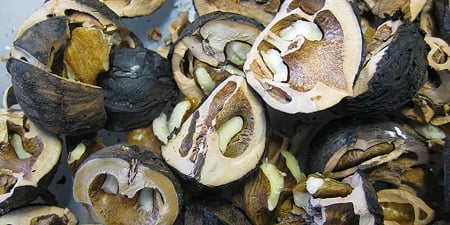
You’d think that if anything would bring out the Greed of Man in me, it would be truffles, a sexy, intoxicating food that can fetch $300 a pound or more. Yet I’ve given plenty of them away to my friends without a second thought.
No, what really makes me feel like Gollum from Lord of the Rings, the wild food I hold most precious, is my store of shelled black walnuts. Don’t even ask. You can’t have any. They are mine I tell you, all mine!
For those of you who don’t know what a black walnut is, it is a generic term for the wild walnuts native to North America. There is one main species east of the Rockies, two in California, and a couple of others in Arizona and Texas. Black walnuts are, more or less, related to hickory nuts and butternuts.
What’s the difference between black walnuts and the kind you get in the store? The vast majority of walnuts you buy in stores are English (also called Persian) walnuts, which are larger and easier to shell than black walnuts. In some places you can buy them in stores, and you can buy black walnuts online.
Size is not the main difference between black walnuts and domesticated ones. Flavor is. Black walnuts taste far stronger than regular ones: More concentrated, walnut-y, and even a touch more bitter.
To me they are the difference between cream and skim milk, grouse and chicken, a wild strawberry and one of those gigantic ones grown on the coast of California. I will take black walnuts over regular ones any time, and for any price.
Luckily that price is free: Black walnut trees grow all around us here in Northern California. My friend Josh tipped me off to a great spot, too, which has so many old trees it took my just 10 minutes to fill two 5-gallon buckets.
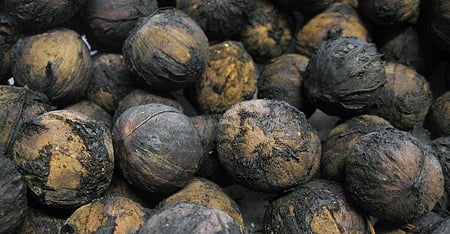
OK, maybe I lied. Black walnuts are not free — if you take time into consideration. Nothing I have ever done, not winemaking, gardening, big-game hunting, processing acorns or curing olives is as labor-intensive as harvesting, hulling and shelling black walnuts. As my fellow forager Connie Green says, “black walnuts are a fortress.” Here’s the method I figured out to storm the gates.
First you need to harvest the walnuts at the correct stage of ripeness.
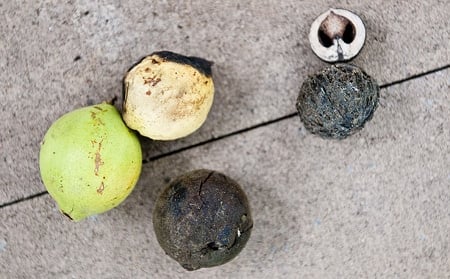
For starters, walnuts will probably not be ripe where you live until October, so wait until then to begin. November should be fine, too, and you can pick up fallen nuts from the ground around the trees into December, but by then our Little Gray Friends the squirrels will have had at them.
So you’re standing at a tree. You see all these forms of walnuts in front of you. Which to pick?
Green ones will most likely still be on the trees. Yes, you can collect them, but they have a surprise in store for you. The beige ones are rotting green ones — they are the hardest to work with, but the nut inside will still be fine. The black one at the bottom is how you will find most of your walnuts: It has its hull rotted and is pretty dry. Finally, if you’ve had lots of rain, you will find some nuts that will be pre-hulled, like the one under the half-shell.
Pick only pre-hulled walnuts that feel heavy for their size, as they will dry out in the shell once hulled.
For the most part, you will need to hull your walnuts. Lots of people say you should just drive over them with a car, but this stains your driveway. Stain? Why yes. Black walnut juice stains like nothing else. And it will not come off with any amount of scrubbing. If you fail to wear gloves when you hull black walnuts, you will have the Black Hand of Death for several days.
Sam Thayer, in his book Nature’s Garden, suggests stomping on the hulls in the field to get them off. This works, but incompletely in my experience with Northern California walnuts, Juglans hindsii. So I sit outside on my porch with three buckets — one with walnuts in it, one for the soon-to-be-hulled walnuts, and one for the hulls. I then don gloves and use a pocketknife to hull the nuts by hand.
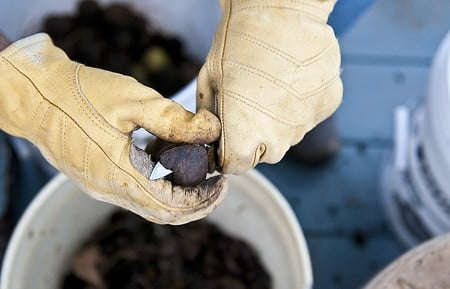
You want a relatively dull knife that you can slice with and not be in danger of it piercing your work gloves. The work can get a little slippery, especially with the green walnuts — remember the surprise? That’s it. A half-hulled green walnut is slipperier than goose shit on a doorknob. This is why I prefer the walnuts with the fully rotted black hulls.

Beware when you are hulling walnuts outdoors. Our Little Gray Friends could be lurking anywhere, just waiting to steal your walnuts for themselves. I use a biological countermeasure to keep the squirrels away:

Once hulled, your work has just begun. Now you must shell your walnuts.
This is the point at which you can kick back a bit. Hulled walnuts store well in the shell, and in fact crack better once they’ve dried for a few weeks.
Once you start shelling, however, you need to banish from your head all notions that you will be able to crack black walnuts and get those pretty perfect halves you can get with regular walnuts. Won’t happen. Bits and pieces are the price of precious black walnut meats.
I crack mine with a hammer, on the concrete floor of my garage. Such force is necessary. I’ve never heard of a regular nutcracker fierce enough to break a black walnut, although some people in the Midwest, where the Eastern species lives, have created special black walnut shellers. Anyone ever use one? I’ll buy one if they work well…
The key to the hammer technique is to use a terrycloth towel to cover the nuts, so the pieces don’t fly all over the room. Use a towel you don’t care about, as it will get holes. Smack the nut with enough force to break it, but not enough to pulverize the nut; after a few, you’ll get the hang of it.
So now you have a bucket of cracked nuts. You’re still not done! Now you need to gently remove the meats from the impossibly complex interior of the walnut. I find the best piece of equipment to do this is a stout pair of wire cutters and a nutpick. I use the wire cutters to clip the shells in key spots so larger pieces of walnut fall out. Again, after a few dozen nuts you’ll begin to know where to clip. The nutpick’s use is obvious. This is tedious work, people. I do it while watching football.
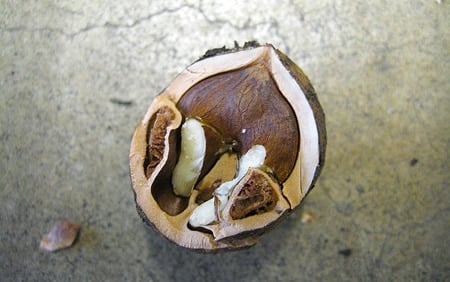
Let me tell you before you begin a black walnut adventure that you need to be patient. It took me probably six hours of work to get 15 ounces of nutmeats — although that includes hulling all of my nuts, not just the portion I cracked and picked. But all this work is worth it.
Just the aroma of black walnuts is payment for the effort: They smell toasted without actually being so. And I’ve already mentioned the flavor, which is so strong many recipes say just half the amount of black walnuts will fully replace the flavor of regular ones. I’m not so sure about that, but you can use a bit less. If you want.
Which brings me, finally, to what I do with my black walnuts. In holiday season, I make a Christmas cookie from my childhood:
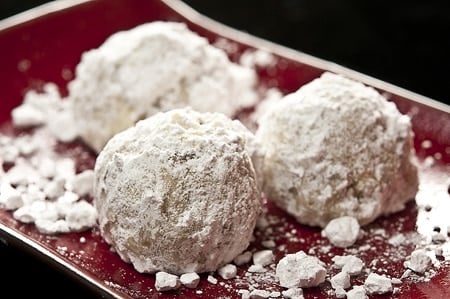
It is my version of a traditional walnut snowball cookie, also known as a Russian teacake or a Mexican wedding cake. My version has black walnuts, of course, but also orange flower water and a little orange liqueur. It’s an awesome cookie, a riff off one my mum has made for decades.
These cookies are stupid easy to make — no mixer necessary, just clean hands — and are so good you really need to make a double batch, because you will eat half of them before your friends or family come home. Trust me on this one.





Hi, I picked some black walnuts hoping to pickle them, but they appear to have already started developing the inner shell (a light brown color). Can I use them for something else now? Will they ripen up? Any suggestions? Thanks!
Gloria. Yep, over time. But they do last several months. If you have some from last October, they might be pretty iffy right now.
Do black walnuts go bad if theyre hulled but not cracked for a long time?
It’s that time again! We found a loaded tree in an abandoned mill site near Healdsburg last weekend. As you mention, the dried-out black ones are already ready to crack open, so we thought about just setting the green ones out in the sun to finish drying instead of hulling the flesh. Should we be worried about rot or taste? Looking forward to your recipe!
I began cracking my walnuts this year and used a hammer against the towel-covered walnut on a cement floor. I ordered the “Hunt’s Black Walnut Nut Cracker” from H&C Nut Cracker Company, P.O. Box 36711, Des Moines, IA 50315 and have been much relieved to be able to crack the walnuts at the kitchen table without flying shells or accidentally hammering my fingers. Thanks for the information–especially about letting the meat dry before storing it.
After years of using a bench vise to crack black walnuts, due to arthritis I bought one of the lever things. It works great for me. I read where. It takes on average, about 600 pounds of pressure to crack the nut. The lever device sort of shatters the nut but usually the meat comes out in four good size pieces. For me it was worth the money.
Awesome article, Hank! My basement floor here in Michigan is covered with hulled black walnuts, just drying out a bit before the task of shelling them begins. I have a 2 X 4 with a 1 5/8″ hole drilled through it which I use to hull my walnuts. Smack ’em through the hole with a rubber mallet into a bucket below. I then barely cover them with water and, similar to another blogger, I use a cordless drill with one of the paint mixing wands attached. The mixing action and the abrasiveness of the nuts whipping around in the bucket cleans the hulls off easily, although you may have to change the water a couple of times.
When it comes to shelling them, I use a bench vise. I cover the top with a plastic bowl to redirect errant pieces of shell and nutmeat and rig up a cardboard contraption to direct the pieces into a bucket on the floor. I use a nut pick to remove the meat. Biggest problem I have is eating as I pick. Takes me forever to amass enough nuts for a recipe. Still, processing black walnuts is a wonderfully rewarding way to kill several weeks during winter!
By the way, my wife got me your book for Father’s Day. I really enjoyed it. Keep up the good work, and Happy Thanksgiving!
I remember harvesting black walnuts as a child from my grandparents yard…gave us grandkids something to keep us busy! Our reward was holiday fudge! We were given gloves and buckets, but often ended up with stained hands anyway! This was typically October in WV, we’d hull a bit later, after they sat and turned ‘blacker’ a while then the nuts had to dry until right before the big event and it was cracking time. Only the older kids were allowed to do this, as hammers were required! We cracked and picked for days on end at times, and I loved every minute of it! I was the eldest grandchild, so I have to remind some of the younger ones of details when we reminisce at holidays now. My grandparents are long gone, but their love for black walnuts will live on in me forever. There is no flavor like that!
We dried them on newspaper in the basement before hulling, which happened on the paper as well, then the cleanup of hulls was a bit easier. I remember stepping on them and rolling them mostly, but I’m sure that’s much less practical than some of the methods I’ve seen here! The nuts were put into buckets and after cleanup, were laid out on a fresh layer on paper to dry for the time remaining, a few greener ones were put in the oven on low (150-200) for a while (couple hours or so maybe, not sure on that). We always used hammers to open the nuts and were praised on larger chunks, altho with fudge, the chips were just fine!
I have collected a nice batch from a neighbor and am looking very much forward to holiday fudge this year, as I knew it as a child! In looking up methods of hulling and cracking, I came across this page and want to say thank you for bringing back those great memories and you can only imagine the impact that my holiday packages this year will bring to many families of my cousins who lived this with me! Yes, they’re all getting walnut fudge!
I live in London, Ontario and we have a long row of black walnut trees. They make the deck lethal in September and the darned squirrels don’t help. Apparently they only produce nuts every other year (so says my arborist) and this year is a bumper crop. I have started collecting and hulling. Thanx for the helpful hints.
Great blog. The walnuts here in the East have thicker husks. I gathered 80 pounds this year. I used Samuel Thayer’s husking method, but I’m not sure if it works on Western walnuts. Anyway, I just used a 6 foot long heavy stick to “stomp” them. They usually split right open, and you can remove the husk by hand.
I should have a more detailed account up on my foraging/art blog soon.
Nate
Black walnuts are indeed a rare treat. I try to at least harvest and hull a couple cups (uh, that’s about 5 hours) so I can make the incomparable black walnut ice cream, ooooh wee doggie it’s intense, rich and good.
Wow! What a memory you’ve brought back. When I was a kid in the 70s, we were friends with a family that had an orchard of 20 acres of black walnuts down in Visalia. I remember the harvesting and the walnut juice stains all over EVERYTHING. And we must have saved the hulls, because my grandmother was a weaver/spinner/dyer and I know she used the walnut hulls at one time or another.
I just stumbled across your blog, and will definitely be back…
This isn’t what my grandmother used, but looks promising – https://www.pleasanthillgrain.com/corn_sheller_hand_operated_crank_manual_antique_walnut_stationary.aspx
They even promise walnut hulling.
I grew up in Ohio and my grandmother regularly made Black Walnut Cake. It is one of my favorite childhood food memories. I have recreated the recipe (we could not find it) by talking to my relatives and researching recipes for the cake. There is a great article and recipes for black walnuts in Raymond Sokolov’s book, “Fading Feast.” The tree that grows in Ohio is the American Eastern black walnut. Incredible, distinctive flavor. I purchase them now from Hammons Nuts. I don’t have access to the trees in Northern CA and I don’t have the patience to go through hulling/cracking process. There is also Black Walnut ice cream, an incredible, traditional dessert. I wrote an article on black walnuts for the “San Jose Mercury News” quite a few years ago. Wonder if it is still available online? We do own a gingko tree, Hank. Have you had any experience with gingko nuts?
Thanks for this great article. I enjoyed the memories that returned to me of my frustration of that wonderful nut meat so close and yet so hard to acquire. My family tried many methods none to any success. I’m amazed if you can really get more than 6 ounces in 6 hours. I must try your way!
Joy
I live in the lower peninsula west coast side of Michigan, Muskegon to be exact.
Black walnuts trees abound. I seem to be the only one other than the squirrels collecting them.
Lucky me……
I use a hammer to remove the hulls while they’re green green/yellow
it’s messy but once you get the hang of it, it ain’t so bad.
Banana nut bread made with black walnuts rules.
I don’t even mind the occasional bit of tooth jarring shell.
My mother always gave the task of cracking open walnuts during the holiday season. She would always be gifted with a grocery bag full of walnuts by someone at work — she would bring them home — and it was my job to shell them so she could use the meats for holiday treats. My method — which I developed over the course of a few years — works pretty darn well. I use one of those gallon sized ziplock backs — fill it with 20 to 30 walnuts and seal it shut. I then lay the bag o’ nuts flat on a concrete surface — and make sure the tip of each nut is pointing up. I then deliver a nice whack with a hammer — and if I do it right with just the right pressure — I can crack that shell into four or five pieces without harming the nut inside.
Another source of already shelled nuts? The American Legion Hall in Rio Linda. Someone out there has access to many a tree — and you’ll find quart-sized bags of already shelled walnuts for $3 to $4 per bag. Unlike the nuts you find in your local supermarket — these have that “freshly hulled” smell.
Oh, good grief! I’ve had a black walnut tree right next to my house that’s housed a family of fox squirrels for ages. I always thought it was some sort of poisonous squirrel delicacy bearing tree 😉
Very informative post; thank you. There are still some entirely blackened ones on the tree that apparently I’m going to get down in the next few days and check out.
When I was a little kid, maybe four years old, and we were poor (I had a single mom who was an artist) my mom and I used to take burlap sacks and walk around town picking up black walnuts. There were trees all over our neighborhood, including one in our front yard. My mom hated it because it dropped the walnuts in the lawn. She disdained black walnuts–her dad was a farmer who had an English walnut orchard, and she thought black walnuts were too much work. I always thought they were pretty much impossible to crack without smashing the nut to bits. But anyway, we would walk around with our gunny sacks and pick up walnuts and sell them to this little market in town. I’d completely forgotten about this. Your picture of the walnuts in different stages of development took me back. They are so familiar to me, but I haven’t seen a black walnut in years and I think most of those trees have been cut down now. Cities don’t like trees that make a mess.
I miss our old house, not for the house itself but for our black walnut trees. Every harvest season they’d drop on the ground and we’d roll over them with our cars. The cracked walnuts gave off the most amazing smell 🙂 🙂 So proud to be blogging with you for Share Our Strength! (I did the soup course). My mother used to make these cookies…and I’d forgotten *Going to look for her recipe* 😀 Cheers!